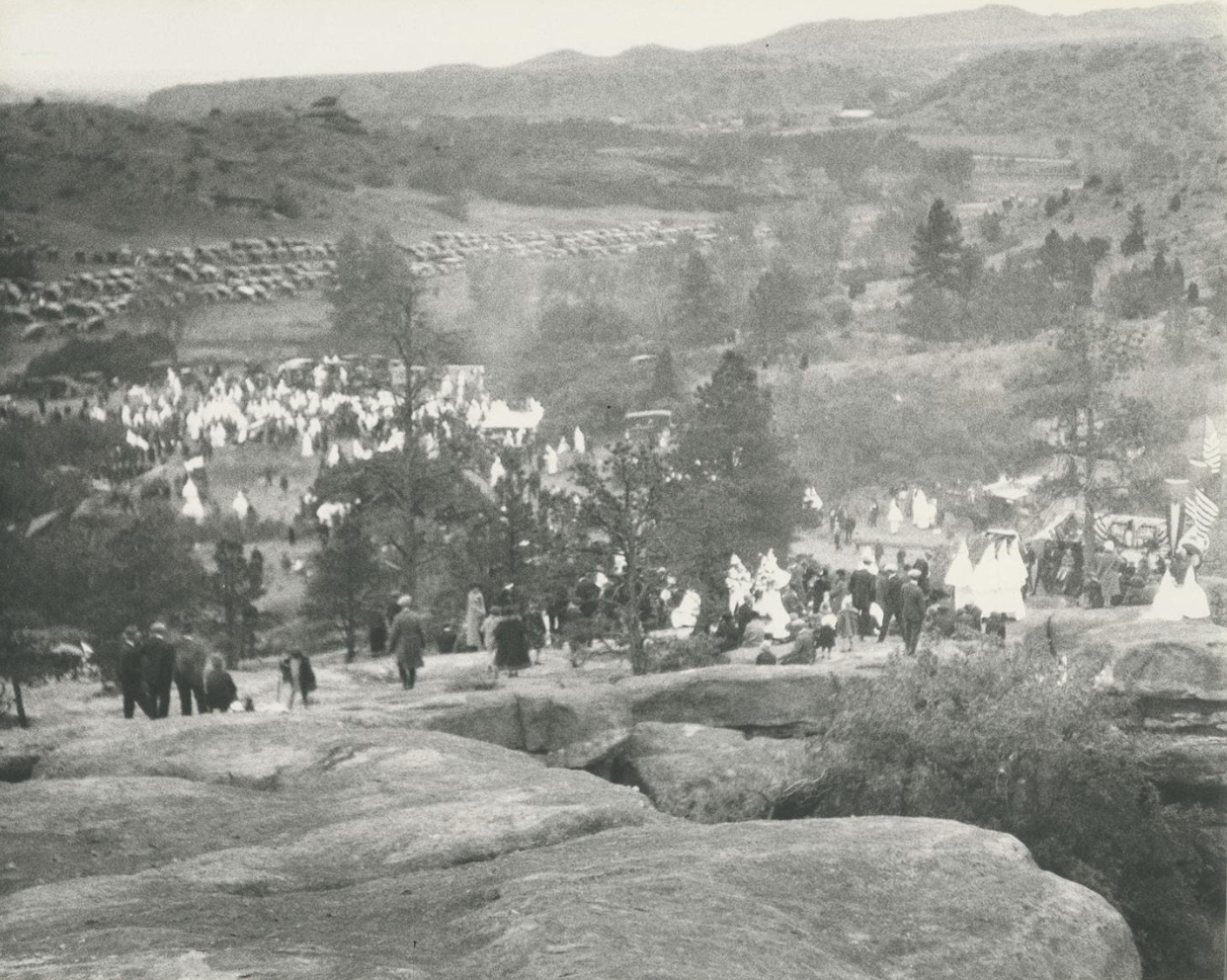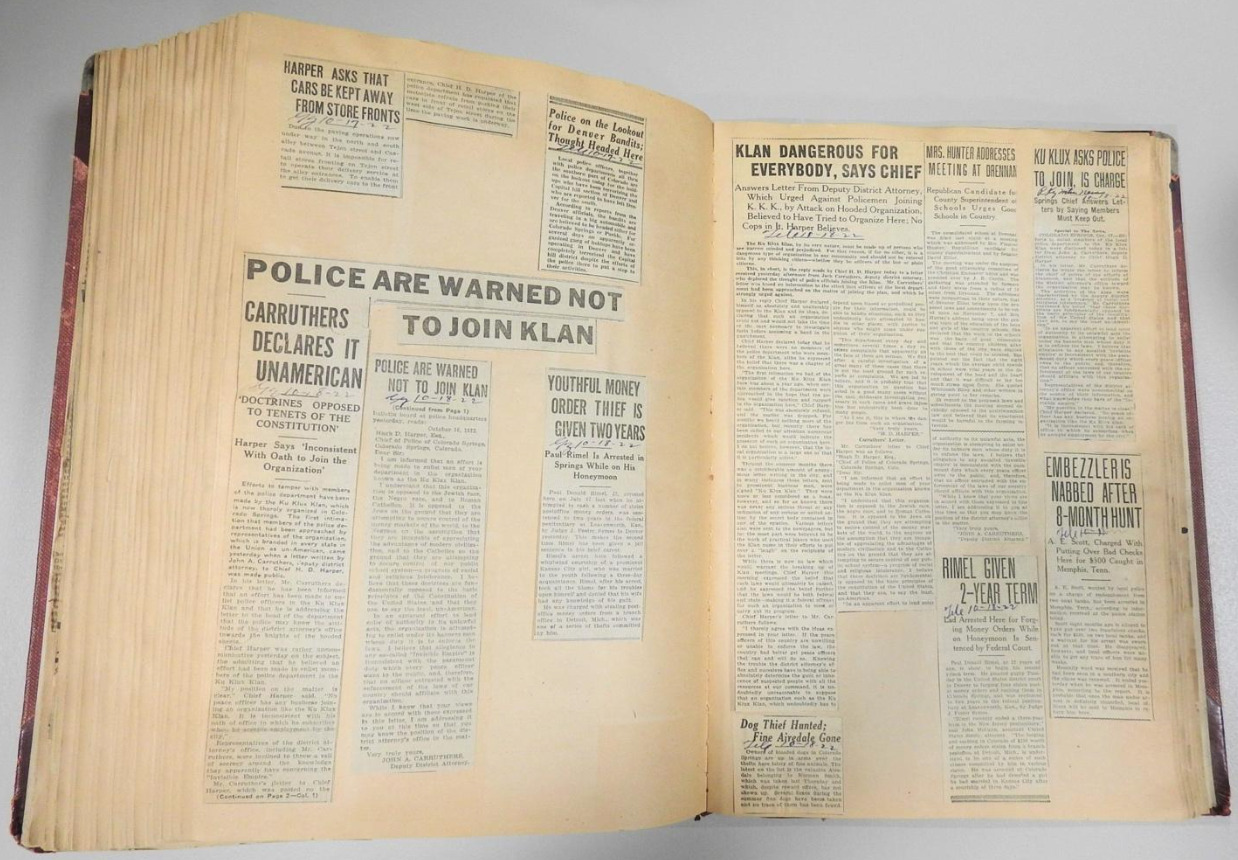The Klan in Colorado Springs

“KKK members standing in front of a cross at Pikes Peak.” July 4th, 1923. Denver Public Library Western History Collection. Accessed from https://www.denverpost.com/2021/06/06/denver-kkk-history/.
Following successes in Denver, the Ku Klux Klan formed a new chapter in Colorado Springs. Although this new chapter hoped to gain similar success, it faced many difficulties in accomplishing its goals.
The Klan in Colorado originally began in Denver, but soon spread to nearby towns and cities such as Colorado Springs in hopes of gaining more influence and followers. The 30,605 residents of Colorado Springs were overwhelmingly Protestant, with only 500 Jews and 2,965 Catholics, and thus seemed like an ideal location for the Klan to penetrate.
In 1921, the Klan immediately sought to gather support from local organizations— a strategy that worked well for them in Denver. However, many in the community, the police included, were weary of the Klan. After sending a letter to a veteran’s group that was deemed to be a veiled threat, the Klan was met with fervent backlash from local organizations. The leadership of the American Legion condemned the Klan and emphasized its lawbreaking, and Reverend Charles A. Fulton denounced the Klan to his congregation. The Klan’s attempts to gain support in Colorado Springs were deemed a failure and they retreated for the time being
Two years later, on July 4th, 1923, the day following a local screening of Birth of a Nation, Klansmen set ablaze a 30-foot-tall cross on Pikes Peak near Colorado Springs. This marked the creation of a new Klan chapter that sought to renew previous efforts. As before, Klansmen sought connections with local groups but now attempted to invoke fears about the town’s bootlegging Catholics and presented themselves as a lawful solution.
However, the Klan faced multiple problems bringing their goals to fruition. Although anti-Catholicism was no doubt present in the majority Protestant population, many did not view Catholics as an immediate threat. Thus, the Klan offered a violent and militant solution that offered little appeal. Bootlegging, a prominent crime in Colorado Springs that was often used to scapegoat Catholics, was being dealt with by the actual law enforcement, and the Klan’s vigilantism was not seen as needed by the police and citizens. Colorado Springs was a popular tourist destination and residents feared that the Klan’s violent image could negatively affect their commerce and industry. The Klan’s frequent crises of local leadership also did not help their cause. During their brief presence in Colorado Springs during the 1920s, four different men acted as the local leader or “Exalted Cyclops.” Two of these leaders were deposed before the end of their term.
Although the Klan did not initially vacate the city this time, its unpopularity drove the Klan to operate from the shadows. Klan activities in Colorado Springs during the 1920s mostly consisted of debate and discussion at lodge meetings, and the occasional cross-burning. The Colorado Springs Chapter only appeared once publicly during the 1920s. Not even daring to show themselves in Colorado Springs, they decided to make a donation to a church in the nearby municipality of Fountain resulting in an uproar.
Following their actions in Fountain and the subsequent backlash, the Colorado Springs Klan chapter shrank and eventually dissipated. Although reaching a notable member count of 2,000 during the 1920s, a combination of poor leadership and uninterested potential members resulted in the Colorado Springs chapter of the Klan not having the same amount of success as their Denver neighbors in gaining membership and influence during the 1920s.
Images

“KKK members standing in front of a cross at Pikes Peak.” July 4th, 1923. Denver Public Library Western History Collection. Accessed from https://www.denverpost.com/2021/06/06/denver-kkk-history/.

“The Ku Klux Klan in Garden of the Gods.” 1925. Colorado Springs Pioneers Museum. Accessed from https://www.cspm.org/cos-150-story/ku-klux-klan/.

“Colorado Spring Police Department Scrapbook.” 1922. Colorado Springs Pioneers Museum. Accessed from https://www.cspm.org/cos-150-story/ku-klux-klan/.